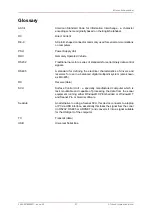
Micron Echosounder
0650-SOM-00001, Issue: 02
14
© Tritech International Ltd.
4. Operation
Note
The output from the Echosounder can be in serial or analogue format. This
section only covers applications which use the data in serial format.
4.1. Output Strings
The serial output is either interrogated (i.e., the software asks for a response) or free-running
and will continuously send out acoustic pulses and supply the output from the Echosounder
to the connected computer even if the software is not running.
The output is an ASCII data string terminated with a carriage return and line feed (
<CR><LF>
)
and will be in one of three formats depending on the hardware settings. These formats are
as follows:
3P2
xxx.xxm<CR><LF>
xxx.xx
= range in metres to 2 decimal places
m
= units label for metres
<CR><LF>
= carriage return and line feed terminators.
3P3
xxx.xxxm<CR><LF>
xxx.xxx
= range in metres to 3 decimal places
m
= units label for metres
<CR><LF>
= carriage return and line feed terminators.
NMEA
$DBT
$PADBT,xxx.xx,f,yyy,yy,M,zzz.zz,F*hh<CR><LF>
xxx.xx
is the range in feet
yyy.yy
is the range in metres
zzz.zz
is the range in fathoms
hh
is an 8-bit checksum
<CR><LF>
= carriage return and line feed terminators.
In free running mode the unit will start to output data immediately upon power up. If the
Echosounder has been set to interrogate mode it will not output data until the interrogate
command (
Z
) is received, at which point a single data string is transmitted to the surface
computer.
To confirm which mode the Echosounder is in a simple test is to power on the unit and listen
for any audible clicks or pings. In free running mode the Echosounder will start pinging as
soon as it receives power but in interrogated mode it should remain silent.







































